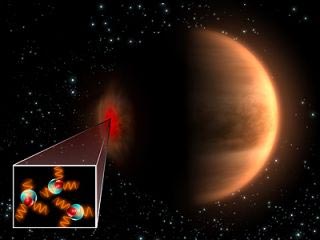Discover important molecules in Venus's atmosphere
Venus Express first detected hydroxyl molecule on another planet. This discovery gives scientists a new tool to decipher the mechanism of Venus's dense atmosphere.
Hydroxyl, an important but difficult to detect molecule, is made up of a hydrogen atom and an oxygen atom. It was discovered on the upper floor of the Venusian atmosphere, about 100km from the surface thanks to the visible infrared thermal imaging spectra of Venus Express, VIRTIS.
This molecule was discovered by manipulating the spacecraft away from the planet and searching along the faint display layer of the atmosphere surrounding Venus's plate. The tool detects the hydroxyl molecule by measuring the amount of infrared rays they emit.
The wavelength range of the atmosphere in which hydroxyl molecules shine is very narrow, only about 10 km wide. By observing the planet's halo, Venus Express searches along the dim atmosphere, increasing the signal strength to about 50.

Hydroxyl, an important but difficult to detect molecule, is made up of a hydrogen molecule and an oxygen molecule.It was discovered on the upper floor of the Venusian atmosphere, about 100km from the surface thanks to the visible infrared thermal imaging spectra of Venus Express, VIRTIS.(Photo: ESA / C.Careau)
Hydroxyl is thought to be important for any atmosphere of any planet because it is highly reactive . On Earth it plays a key role in eliminating waste from the atmosphere and is thought to help stabilize CO 2 in Mars's atmosphere, preventing it from being converted into CO. On Mars, it is thought to play a key role in destroying life in the soil, making the top soil dangerous to microbial life.
According to Giupese Piccioni, of Istituto di Astrofisica Spaziale e Fisica Cosmica in Rome, Italy, one of the main investigators of the VIRTIS experiment, 'Because the atmosphere of Venus has never been thoroughly studied before Venus Express approached, we have not been able to confirm most of our experiments by observing what actually happened. This discovery will help us redefine patterns and learn more. '
On Earth, the sparkle of hydroxyl in the atmosphere has been shown to be strongly related to ozone excess. From this work, the same thing is said to be true for Venus. Now, scientists can establish the amount of ozone in the planet's atmosphere.
Venus Express has proved that the amount of hydroxyl on Venus changes highly. It can change about 50% from one orbit to the next and this may be due to the change in ozone in the atmosphere.
According to Piccioni 'Ozone is an important molecule for any atmosphere, because it is a strong absorber of ultraviolet radiation from the sun.' The amount of absorbed radiation is an important parameter that controls the temperature and kinetics of a planet's atmosphere. On Earth, it heats the stratosphere, making the stratosphere stable and protecting the biosphere from harmful ultraviolet rays.
Current computer calculations can show how an increase or decrease in ozone levels in a short period of time affects Venus's relentless working atmosphere.
'Venus Express has shown us that Venus is more like the earth than we once thought. The detection of hydroxyl brought it almost one step closer. '
He and his colleagues only reported their initial findings from a few orbits in the most recent work. They are working with analysis of data from 50 other orbits and subsequent observations will continue.
The first discovery of hydroxyl in the Venus atmosphere by G. Piccioni et al. published in Astronomy & Astrophysics Letters.
- The first organic molecule on an extraterrestrial planet
- USD 750,000 from NASA for anyone who finds a way to turn CO2 on Mars into other molecules
- Discover the 'melody' of DNA molecules
- New discovery about the motion of water molecules
- Curiosity finds organic molecules on Mars
- Discover the molecules needed for life around a super giant star
- Strange molecules wipe acid rain
- Video: Discover the shape of a molecule
- Dust molecules help limit climate change?
- Ozone in Venus's atmosphere
- Detects molecules that spread HIV in humans
- Detecting chemicals is thought to form life
 Van Allen's belt and evidence that the Apollo 11 mission to the Moon was myth
Van Allen's belt and evidence that the Apollo 11 mission to the Moon was myth The levels of civilization in the universe (Kardashev scale)
The levels of civilization in the universe (Kardashev scale) Today Mars, the sun and the Earth are aligned
Today Mars, the sun and the Earth are aligned The Amazon owner announced a secret plan to build a space base for thousands of people
The Amazon owner announced a secret plan to build a space base for thousands of people How was the environment and climate of Earth during the dinosaur era different from today?
How was the environment and climate of Earth during the dinosaur era different from today?  NASA to test 'pneumatic brakes' for Mars lander
NASA to test 'pneumatic brakes' for Mars lander  If you told me that the Earth's atmosphere covers the entire Moon, would you believe it? It's true!
If you told me that the Earth's atmosphere covers the entire Moon, would you believe it? It's true!  How heavy is the Earth's atmosphere?
How heavy is the Earth's atmosphere?  The Truth About the Solar System's 3rd Habitable Planet
The Truth About the Solar System's 3rd Habitable Planet  One of the most terrifying super-Earths in the universe revealed
One of the most terrifying super-Earths in the universe revealed 